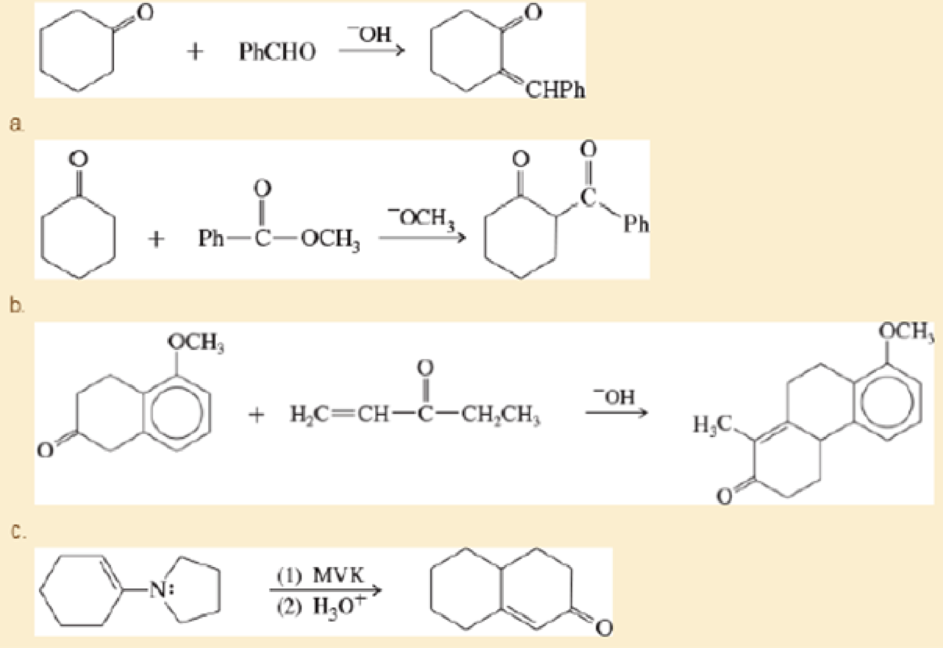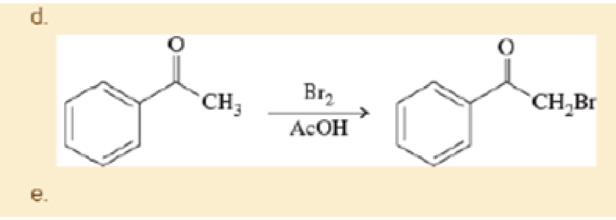
Organic Chemistry, Books a la Carte Edition (9th Edition)
9th Edition
ISBN: 9780134160382
Author: Leroy G. Wade, Jan W. Simek
Publisher: PEARSON
expand_more
expand_more
format_list_bulleted
Concept explainers
Textbook Question
Chapter 22, Problem 22.77SP
Propose mechanisms for the following reactions.


Expert Solution & Answer
Want to see the full answer?
Check out a sample textbook solution
Students have asked these similar questions
Provide photos of models of the following molecules. (Include a key for identification of the atoms)
1,2-dichloropropane
2,3,3-trimethylhexane
2-bromo-3-methybutane
Please draw the structure in the box that is consistent with all the spectral data and
alphabetically label all of the equivalent protons in the structure (Ha, Hb, Hc....) in order to assign all
the proton NMR peaks. The integrations are computer generated and approximate the number of
equivalent protons. Molecular formula: C13H1802
14
13
12
11
10
11 (ppm)
Structure with assigned H peaks
2.08
3.13
A 0.10 M solution of acetic acid (CH3COOH, Ka = 1.8 x 10^-5) is titrated with a 0.0250 M solution of magnesium hydroxide (Mg(OH)2). If 10.0 mL of the acid solution is titrated with 10.0 mL of the base solution, what is the pH of the resulting solution?
Chapter 22 Solutions
Organic Chemistry, Books a la Carte Edition (9th Edition)
Ch. 22.2A - Prob. 22.2PCh. 22.4 - Without looking back, propose a mechanism for the...Ch. 22.4 - Prob. 22.8PCh. 22.4 - Prob. 22.9PCh. 22.5A - Prob. 22.10PCh. 22.5A - Prob. 22.11PCh. 22.5B - Prob. 22.12PCh. 22.5B - Predict the products of the following reactions....Ch. 22.5B - Which compounds will give positive iodoform tests?...Ch. 22.5C - Propose a mechanism for the acid-catalyzed...
Ch. 22.5C - Acid-catalyzed halogenation is synthetically...Ch. 22.6 - Show the products of the reactions of these...Ch. 22.7A - Prob. 22.18PCh. 22.7A - Prob. 22.19PCh. 22.7A - Prob. 22.20PCh. 22.7B - Prob. 22.21PCh. 22.8 - Prob. 22.22PCh. 22.8 - Prob. 22.24PCh. 22.9 - Prob. 22.25PCh. 22.9 - Prob. 22.26PCh. 22.9 - Prob. 22.27PCh. 22.9 - Prob. 22.28PCh. 22.9 - Prob. 22.29PCh. 22.10 - When cyclodecane-1,6-dione is treated with sodium...Ch. 22.11 - Prob. 22.32PCh. 22.11 - Prob. 22.33PCh. 22.12 - Prob. 22.34PCh. 22.12 - Prob. 22.35PCh. 22.12 - Prob. 22.36PCh. 22.12 - Prob. 22.37PCh. 22.12 - Show what esters would undergo Claisen...Ch. 22.13 - Prob. 22.39PCh. 22.13 - Prob. 22.40PCh. 22.14 - Prob. 22.41PCh. 22.14 - Prob. 22.42PCh. 22.14 - Show how crossed Claisen condensations could be...Ch. 22.14 - Prob. 22.44PCh. 22.14 - Prob. 22.45PCh. 22.15 - Prob. 22.46PCh. 22.16 - Prob. 22.47PCh. 22.16 - Prob. 22.48PCh. 22.17 - Prob. 22.49PCh. 22.17 - Prob. 22.50PCh. 22.17 - Prob. 22.51PCh. 22.18 - Prob. 22.52PCh. 22.18 - Prob. 22.53PCh. 22.18 - Prob. 22.54PCh. 22.18 - Prob. 22.55PCh. 22.18 - Prob. 22.56PCh. 22.19 - Prob. 22.57PCh. 22.19 - Prob. 22.58PCh. 22.19 - Prob. 22.59PCh. 22 - Prob. 22.60SPCh. 22 - 1. Rank the following compounds in order of...Ch. 22 - Prob. 22.62SPCh. 22 - Prob. 22.63SPCh. 22 - Prob. 22.64SPCh. 22 - Pentane-2,4-dione (acetylacetone) exists as a...Ch. 22 - a. Rank these compounds in order of increasing...Ch. 22 - Prob. 22.67SPCh. 22 - Prob. 22.68SPCh. 22 - 22-69 Predict the products of the following...Ch. 22 - Predict the products of these reaction sequences.Ch. 22 - Show how you would accomplish the following...Ch. 22 - Prob. 22.72SPCh. 22 - Prob. 22.73SPCh. 22 - Prob. 22.74SPCh. 22 - The Knoevenagel condensation is a special case of...Ch. 22 - Prob. 22.76SPCh. 22 - Propose mechanisms for the following reactions.Ch. 22 - Prob. 22.78SPCh. 22 - Show how you would accomplish the following...Ch. 22 - Prob. 22.80SPCh. 22 - Propose a mechanism for the following reaction....Ch. 22 - Prob. 22.83SPCh. 22 - Prob. 22.84SPCh. 22 - Prob. 22.85SP
Knowledge Booster
Learn more about
Need a deep-dive on the concept behind this application? Look no further. Learn more about this topic, chemistry and related others by exploring similar questions and additional content below.Similar questions
- Firefly luciferin exhibits three rings. Identify which of the rings are aromatic. Identify which lone pairs are involved in establishing aromaticity. The lone pairs are labeled A-D below.arrow_forwardA 0.10 M solution of acetic acid (CH3COOH, Ka = 1.8 x 10^-5) is titrated with a 0.0250 M solution of magnesium hydroxide (Mg(OH)2). If 10.0 mL of the acid solution is titrated with 10.0 mL of the base solution, what is the pH of the resulting solution?arrow_forwardGiven a complex reaction with rate equation v = k1[A] + k2[A]2, what is the overall reaction order?arrow_forward
- Please draw the structure in the box that is consistent with all the spectral data and alphabetically label all of the equivalent protons in the structure (Ha, Hb, Hc....) in order to assign all the proton NMR peaks. The integrations are computer generated and approximate the number of equivalent protons. Molecular formula: C13H1802 14 13 12 11 10 11 (ppm) Structure with assigned H peaks 2.08 3.13arrow_forwardCHEMICAL KINETICS. One of the approximation methods for solving the rate equation is the steady-state approximation method. Explain what it consists of.arrow_forwardCHEMICAL KINETICS. One of the approximation methods for solving the rate equation is the limiting or determining step approximation method. Explain what it consists of.arrow_forward
- CHEMICAL KINETICS. Indicate the approximation methods for solving the rate equation.arrow_forwardTRANSMITTANCE เบบ Please identify the one structure below that is consistent with the 'H NMR and IR spectra shown and draw its complete structure in the box below with the protons alphabetically labeled as shown in the NMR spectrum and label the IR bands, including sp³C-H and sp2C-H stretch, indicated by the arrows. D 4000 OH LOH H₂C CH3 OH H₂C OCH3 CH3 OH 3000 2000 1500 HAVENUMBERI-11 1000 LOCH3 Draw your structure below and label its equivalent protons according to the peak labeling that is used in the NMR spectrum in order to assign the peaks. Integrals indicate number of equivalent protons. Splitting patterns are: s=singlet, d=doublet, m-multiplet 8 3Hb s m 1Hd s 3Hf m 2Hcd 2Had 1He 鄙视 m 7 7 6 5 4 3 22 500 T 1 0arrow_forwardRelative Transmittance 0.995 0.99 0.985 0.98 Please draw the structure that is consistent with all the spectral data below in the box and alphabetically label the equivalent protons in the structure (Ha, Hb, Hc ....) in order to assign all the proton NMR peaks. Label the absorption bands in the IR spectrum indicated by the arrows. INFRARED SPECTRUM 1 0.975 3000 2000 Wavenumber (cm-1) 1000 Structure with assigned H peaks 1 3 180 160 140 120 100 f1 (ppm) 80 60 40 20 0 C-13 NMR note that there are 4 peaks between 120-140ppm Integral values equal the number of equivalent protons 10.0 9.0 8.0 7.0 6.0 5.0 4.0 3.0 2.0 1.0 0.0 fl (ppm)arrow_forward
- Calculate the pH of 0.0025 M phenol.arrow_forwardIn the following reaction, the OH- acts as which of these? NO2-(aq) + H2O(l) ⇌ OH-(aq) + HNO2(aq)arrow_forwardUsing spectra attached, can the unknown be predicted? Draw the predicition. Please explain and provide steps. Molecular focrmula:C16H13ClOarrow_forward
arrow_back_ios
SEE MORE QUESTIONS
arrow_forward_ios
Recommended textbooks for you

 EBK A SMALL SCALE APPROACH TO ORGANIC LChemistryISBN:9781305446021Author:LampmanPublisher:CENGAGE LEARNING - CONSIGNMENT
EBK A SMALL SCALE APPROACH TO ORGANIC LChemistryISBN:9781305446021Author:LampmanPublisher:CENGAGE LEARNING - CONSIGNMENT Organic ChemistryChemistryISBN:9781305580350Author:William H. Brown, Brent L. Iverson, Eric Anslyn, Christopher S. FootePublisher:Cengage Learning
Organic ChemistryChemistryISBN:9781305580350Author:William H. Brown, Brent L. Iverson, Eric Anslyn, Christopher S. FootePublisher:Cengage Learning


EBK A SMALL SCALE APPROACH TO ORGANIC L
Chemistry
ISBN:9781305446021
Author:Lampman
Publisher:CENGAGE LEARNING - CONSIGNMENT

Organic Chemistry
Chemistry
ISBN:9781305580350
Author:William H. Brown, Brent L. Iverson, Eric Anslyn, Christopher S. Foote
Publisher:Cengage Learning
Coenzymes and cofactors; Author: CH15 SWAYAM Prabha IIT Madras;https://www.youtube.com/watch?v=bubY2Nm7hVM;License: Standard YouTube License, CC-BY
Aromaticity and Huckel's Rule; Author: Professor Dave Explains;https://www.youtube.com/watch?v=7-BguH4_WBQ;License: Standard Youtube License